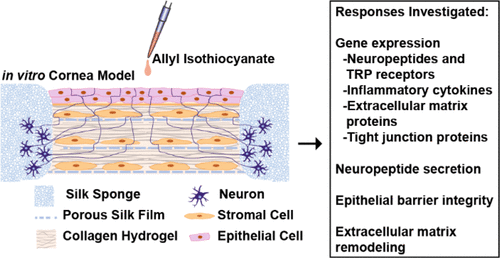当前位置:
X-MOL 学术
›
ACS Biomater. Sci. Eng.
›
论文详情
Our official English website, www.x-mol.net, welcomes your
feedback! (Note: you will need to create a separate account there.)
Induction of Irritation and Inflammation in a 3D Innervated Tissue Model of the Human Cornea
ACS Biomaterials Science & Engineering ( IF 5.4 ) Pub Date : 2020-11-17 , DOI: 10.1021/acsbiomaterials.0c01136 Rachel E. Pollard 1 , Tina B. McKay 1 , Andrew Ford 1 , Dana M. Cairns 1 , Irene Georgakoudi 1 , David L. Kaplan 1
ACS Biomaterials Science & Engineering ( IF 5.4 ) Pub Date : 2020-11-17 , DOI: 10.1021/acsbiomaterials.0c01136 Rachel E. Pollard 1 , Tina B. McKay 1 , Andrew Ford 1 , Dana M. Cairns 1 , Irene Georgakoudi 1 , David L. Kaplan 1
Affiliation

|
Detection of slight changes in the chemical, thermal, and physical environments of the ocular surface is necessary to protect eyesight. The cornea, as the most densely innervated peripheral tissue in the body, can be damaged as a result of caustic chemical exposure. Such damage can be painful and debilitating, thus underscoring the need to understand mechanisms of ocular irritation. Both ethical and translational limitations regarding the use of animal subjects in part drive the need to develop relevant in vitro cell and tissue models that emulate the physiology of the human cornea. In this study, we utilized our 3D in vitro cornea-like tissue model to study the effects of irritation mediated by transient receptor potential (TRP) channels vanilloid 1 and ankyrin 1 (TRPV1; TRPA1) in response to allyl isothiocyanate (AITC) stimulation. Changes in gene expression were analyzed to characterize wound healing responses of the epithelial, stromal, and neuronal cell populations in the corneal tissue models. Key findings of the study include indications of wound healing, such as stromal myofibroblast differentiation and epithelial barrier re-establishment, amplification of pro-inflammatory cytokines, and downstream ECM protein remodeling due to irritation with the addition of sensory innervation. This study further establishes this in vitro tissue model as a useful tool for studying corneal irritation in vitro in a holistic manner with promise as a novel and sensitive tool for studying chemical exposures and subsequent responses.
中文翻译:

在人角膜的3D受神经支配的组织模型中引起刺激和炎症
为了保护视力,必须检测眼表化学,热和物理环境的细微变化。角膜是人体中最紧密支配的外围组织,可能会由于腐蚀性化学物质而受损。这样的损害可能是痛苦的并且使人衰弱,因此强调了了解眼刺激机制的需要。关于使用动物受试者的伦理和翻译上的局限性在一定程度上驱使了对开发模仿人类角膜生理的相关体外细胞和组织模型的需求。在这项研究中,我们利用我们的3D体外角膜样组织模型研究了瞬态受体电位(TRP)通道香草酸1和锚蛋白1(TRPV1; TRPA1)介导的异硫氰酸烯丙酯(AITC)刺激的刺激作用。分析基因表达的变化以表征角膜组织模型中上皮,基质和神经元细胞群体的伤口愈合反应。该研究的主要发现包括伤口愈合的适应症,例如间质成肌纤维细胞分化和上皮屏障重建,促炎细胞因子的扩增以及由于刺激和感觉神经支配引起的下游ECM蛋白重塑。这项研究进一步建立了这种体外组织模型,将其作为一种以整体方式研究角膜刺激的有用工具,并有望作为研究化学暴露和后续反应的一种新颖而敏感的工具。该研究的主要发现包括伤口愈合的适应症,例如间质成肌纤维细胞分化和上皮屏障重建,促炎细胞因子的扩增以及由于刺激和感觉神经支配引起的下游ECM蛋白重塑。这项研究进一步建立了这种体外组织模型,将其作为一种以整体方式研究角膜刺激的有用工具,并有望作为研究化学暴露和后续反应的一种新颖而敏感的工具。该研究的主要发现包括伤口愈合的适应症,例如间质成肌纤维细胞分化和上皮屏障重建,促炎细胞因子的扩增以及由于刺激和感觉神经支配引起的下游ECM蛋白重塑。这项研究进一步建立了这种体外组织模型,将其作为一种以整体方式研究角膜刺激的有用工具,并有望作为研究化学暴露和后续反应的一种新颖而敏感的工具。
更新日期:2020-12-14
中文翻译:

在人角膜的3D受神经支配的组织模型中引起刺激和炎症
为了保护视力,必须检测眼表化学,热和物理环境的细微变化。角膜是人体中最紧密支配的外围组织,可能会由于腐蚀性化学物质而受损。这样的损害可能是痛苦的并且使人衰弱,因此强调了了解眼刺激机制的需要。关于使用动物受试者的伦理和翻译上的局限性在一定程度上驱使了对开发模仿人类角膜生理的相关体外细胞和组织模型的需求。在这项研究中,我们利用我们的3D体外角膜样组织模型研究了瞬态受体电位(TRP)通道香草酸1和锚蛋白1(TRPV1; TRPA1)介导的异硫氰酸烯丙酯(AITC)刺激的刺激作用。分析基因表达的变化以表征角膜组织模型中上皮,基质和神经元细胞群体的伤口愈合反应。该研究的主要发现包括伤口愈合的适应症,例如间质成肌纤维细胞分化和上皮屏障重建,促炎细胞因子的扩增以及由于刺激和感觉神经支配引起的下游ECM蛋白重塑。这项研究进一步建立了这种体外组织模型,将其作为一种以整体方式研究角膜刺激的有用工具,并有望作为研究化学暴露和后续反应的一种新颖而敏感的工具。该研究的主要发现包括伤口愈合的适应症,例如间质成肌纤维细胞分化和上皮屏障重建,促炎细胞因子的扩增以及由于刺激和感觉神经支配引起的下游ECM蛋白重塑。这项研究进一步建立了这种体外组织模型,将其作为一种以整体方式研究角膜刺激的有用工具,并有望作为研究化学暴露和后续反应的一种新颖而敏感的工具。该研究的主要发现包括伤口愈合的适应症,例如间质成肌纤维细胞分化和上皮屏障重建,促炎细胞因子的扩增以及由于刺激和感觉神经支配引起的下游ECM蛋白重塑。这项研究进一步建立了这种体外组织模型,将其作为一种以整体方式研究角膜刺激的有用工具,并有望作为研究化学暴露和后续反应的一种新颖而敏感的工具。











































 京公网安备 11010802027423号
京公网安备 11010802027423号